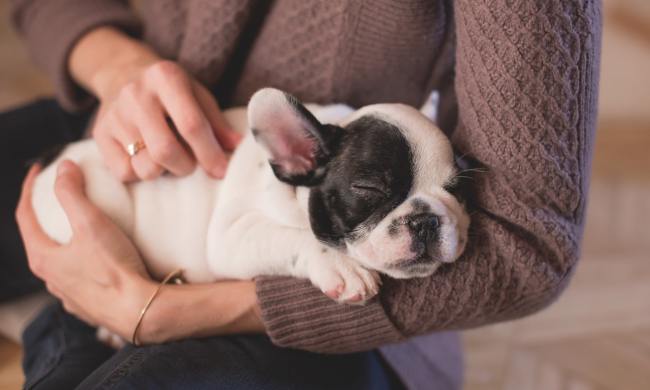If you’re like the majority of pet parents, you’ve probably said “I wish you could talk” to your dog at least once in their lives. Whether trying to solve a behavioral issue, a mystery illness, or just wondering what the heck is running through that furry head of theirs, there’s no doubt that using words would make a world of difference for you both.
If dogs could talk to humans, we could learn a lot more than whether Fido needed to go potty. Technology like this would open doors to canine psychology that scientists could only hypothesize before. We could answer all kinds of questions: Do dogs miss humans when we’re gone? Do our pets truly love us?
Though talking dogs seems like a far-off possibility, it’s more real than you might think — just ask Bunny the Sheepadoodle and Alexis Devine, her human mom.
Bunny the talking dog
Since 2019, notes The Seattle Times, Bunny the poodle mix has been training to interact with over 50 buttons on a soundboard to communicate with her parents and friends. In order to “speak,” she simply presses a talking button with her paw. Each button corresponds to a word or phrase that her mom prerecorded, allowing everyone — human or canine — to understand the meaning of each spot on the soundboard.
Since starting her journey toward communication, Bunny and her family have gathered over 7.1 million followers on their TikTok account (at the time of this writing). It’s easy to see why so many people want to keep up with her endeavors; watching her learn and interact with her family is both mind-blowing and heart-warming.
@whataboutbunny This interaction seems incredible in so many ways: questioning/ referencing the past/ empathy. #fyp #doggyanthem #empathy #talkingdog
They Can Talk project
According to Salon, Bunny is just one of over 2,600 dogs and 300 cats enrolled in a program called They Can Talk. This program’s goal is to understand the extent to which humans and animals can communicate using augmentative and alternative communication (AAC) devices, like Bunny’s buttons.
Skeptics believe that Bunny’s communication skills are simply a result of dedicated training and not spontaneous thought. While no scientific conclusions can be drawn as of yet, the sweet pup’s videos certainly seem like she organically communicates with her mom and family.
How the buttons work
As you will see in her videos, Bunny uses a series of talking buttons to communicate with her owner. Before showing them to her dog, Devine records one word in her own voice — the word that will be played back when Bunny presses the button. This allows Devine to control what and how many words her dog will learn, as well as add an air of familiarity for Bunny.
Most dogs in the They Can Talk project start by learning how to use a single button — “outside.” Devine explains in a video how she and Bunny tackled this process: with consistency and repetition. When she would take Bunny outside, Devine would press the “outside” button, say the word “outside” with her voice, and then let Bunny outside. It took about three weeks before Bunny used the button on her own. You can see it at around 2:30 in the video.
What can we learn from ‘talking’ dogs?
As Bunny’s button skills have advanced, she has been able to communicate more and more complex ideas to her mom. Though science hasn’t confirmed whether she is forming thoughts in the same way humans do, she seems to ask questions that are just as intelligent as a person’s. In fact, she’s even told her mom about her dreams.
Bunny’s thoughts and questions have sparked discussion among canine cognition experts and pet lovers alike, as it’s becoming evident that there is a lot to learn.
@whataboutbunny Then vs. Now?#FreeFreeDance #thenvsnow #bunnythedog #fypシ
Do dogs miss humans when we’re gone?
Recently, Bunny’s dad returned to work after spending months at home during the coronavirus pandemic. As this was such a big adjustment, it’s not surprising that Bunny took notice. What is surprising, though, is how she expressed her concern.
“The first week that he was back at school in the classroom, Bunny was very much asking about Johnny,” Devine told Salon. “[She was] pressing ‘Where dad?’ and ‘Where dad bye?’ for a lot of the day, for several days in a row.”
Though it’s clear that she noticed her dad’s absence, it’s unclear whether she felt negative about it. Some may suggest that her repetitive asking could indicate anxiety, but neither her mom nor canine experts can confirm that. One thing is for sure though — dogs are aware when a member of their pack is missing.
Even though there’s still a lot to learn about the way dogs relate to and communicate with people, there’s certainly nothing wrong with enjoying the process. Watching Bunny’s videos is so fascinating and sweet that we don’t blame you if you want to try the button technique with your own pet! If you’re interested, They Can Talk provides tons of text and video resources for getting started, including some celebrity appearances from Bunny herself!



